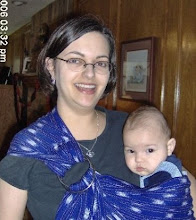Countries with some of the lowest perinatal mortality rates in the world have caesarean rates under 10%. Clearly there is no justification in any specific region to have more than 10-15% caesarean section births.Even more troubling, the VBAC rate (vaginal birth after cesarian) has dropped 13% since last year and 67% since 1996. In many areas of the country, it is extremely difficult to find a doctor or hospital who will take on VBAC patients. The number of preterm and low birth weight babies is also increasing.
What's the cause of this disturbing trend? Ah, well, we can always blame the lawyers:
"The increase in the cesarean births is due to three things — malpractice, malpractice, malpractice," said Dr. Joshua A. Copel, director of Maternal and Fetal Medicine at Yale University School of Medicine.
Copel believes that the decision to do cesarean deliveries is largely based on doctors' fear of litigation. "Not that much has changed about the American population to account for such an increase in cesarean birth rates except the fear of obstetricians of being sued," he said.
...
"Most disturbing are data showing a steady increase in the rate of cesarean delivery," [Dr. David L.] Katz added. "While the so-called c-section can be invaluable when used to address complications of labor and delivery, it appears to be used increasingly for mere convenience, or to avoid liability associated with the natural risks of birthing."
"That we are doing more surgery, but not delivering more prenatal care, is quite concerning," Katz said. "Pregnancy-related care should be a national priority, and delivery a matter of Nature's timing, not the obstetrician's convenience. The trends in this report call for a reassessment of our priorities."
In response to the CDC statistics, the International Cesarean Awareness Network (ICAN) has issued a press release (PDF) focusing on what it terms "forced" cesarean surgeries:
Over 300 hospitals and thousands of physicians across the country have banned vaginal birth after cesarean (VBAC) based on cost concerns and fears over liability. These bans mean that women are pushed into cesareans they do not want and likely do not need...."Every medical and regulatory organization espouses the principles of patients' rights, yet we're finding that the realities these women face don't jive with what's on paper," says Katherine Prown, Ph.D., ICAN's Director of Advocacy.
Red State Moron weighs in and links to the New York Times article.
Experts on the High Rate of Cesareans from vbac.com.
The Assault on Normal Birth: The OB Disinformation Campaign by Henci Goer




1 comment:
My husband is an ob/gyn and works in a small midwestern town at a very good hospital. He and his partners are willing and able to perform VBACs, but will soon stop for a reason not mentioned here. The obstacle is the anesthesiologists. Their hospital requires in-house anesthesia coverage for all VBACs due to insurance requirements and patient care standards. The anesthesiologists hate providing this coverage and have made the situation so politically unbearable that the hospital has decided to abandon VBACs. Of course, patients will never know about this. The community will never know about this. But, the tension between anesthesiologists and obstetricians is fairly well-known in the obstetrical community. If your local hospital or obstetrician does not provide an option to have a VBAC, it is possible that the reason is not the obstetrician, but due to anesthesia coverage issues and/or related insurance coverage issues. I regret I have to post his anonymously, but given the small town we're in and the explosive nature of this issue in our little hospital, I hope you understand.
Post a Comment